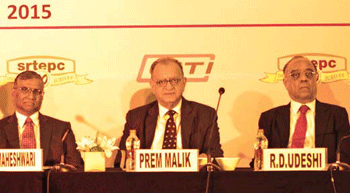
MMF holds huge scope for growth
India is the second largest producer of man-made fibres (MMF) in the world with presence of large plants having state-of-the art technology. MMF textiles constitute almost two-third of the domestic textile market. However, India´s share in global exports of value -added textiles of MMF is miniscule.
L-R: Prashant Agarwal, Jt MD, Wazir Advisors; KK Maheshwari, MD, Grasim; Prem Malik, Chairman, CITI; RD Udeshi, President, Polyester Chain, Reliance Industries; and Anil Rajvanshi, Chairman, SRTEPC.
India is the second largest producer of man-made fibres (MMF) in the world with presence of large plants having state-of-the art technology. MMF textiles constitute almost two-third of the domestic textile market. However, India´s share in global exports of value -added textiles of MMF is miniscule.
MMF industry and its growth in India was the topic of discussion at the recently-held ´Manmade Fibre Textile Conclave´, which was jointly organized by the Confederation of Indian Textile Industry (CITI) and the Synthetic and Rayon Textiles Export Promotion Council (SRTEPC) on March 17, 2015 at Hotel Westin, Goregaon, Mumbai. This was the first time that a conclave related to MMF industry was organised by SRTEPC. Earlier SRTEPC seminars were [always] more focused on the cotton sector of India. Major stalwarts from the textile industry made their presence felt during the conclave.
Inaugural session began with Prem Malik, Chairman, CITI, addressing the gathering. He thanked everyone for the participation and believed more such conclaves should be held every year henceforth. He said, ´Cotton yield is low in India, but even if it gets doubled then our growth in the MMF industry will be tremendous. Industry should focus more on capacity expansion´
RD Udeshi, President´Polyester Chain, Reliance Industries Ltd, said that there has been 6 per cent growth in fibre consumption in India, and MMF is the most important fibre. Speaking about the current status of MMF industry in India, he said, ´India is the second largest producer of MMF in the world, however, if we compare the figures of China [which is the leading producer in the world] to India, the difference in the production capacity between these two countries is huge. India has to do a lot of things to catch up with China.´ He further added, ´India has a lot of scope. Industry needs to work hard and convert it into opportunities. High-quality fabric is the need of the hour.´ An insightful presentation on the future of Indian MMF industry was given by Prashant Agarwal, Joint Managing Director, Wazir Advisors. He stressed on the role of imports, which is impacting MMF industry in India. He said, ´Despite India having abundance of raw materials to flourish in India, major products are imported from foreign countries. This is a major problem which is restricting the growth of MMF in India.´ However he thought investment in MMF based fabric manufacturing is bound to happen. Indian textile industry will consume more polyester than cotton within the next five years.
´China, Taiwan and South Korea are global leaders in MMF industry. Can India catch up with them? India can have a lot of learnings from them in form of joint ventures,´ Agarwal said. He gave an example of Zara stores in India and how it has grown by 43 per cent YoY. ´About 70 per cent of products in Zara stores are MMF based,´ he added. The next to present was KK Maheshwari, Managing Director, Grasim Industries Ltd. He threw light on viscose fibre, which Grasim is the leading producer. He said, ´Indian textile industry is growing significantly, but if we compare it with China, Indian growth is insignificant. China is 7-8 times big than Indian textile industry.´
The inaugural session ended with Anil Rajvanshi, Chairman, SRTEPC, giving the vote of thanks and concluding remarks. He urged the government to provide their support to this growing industry. He averred, ´India only has 10 billion of fibre and need about 25 billion to reach the target.´ However he was optimistic that with the addition, India can touch even 45-50 billion.
The theme of the second session was ´Emerging Trends in MMF technology´.VK Ladia, Past Chairman, CITI, gave th



